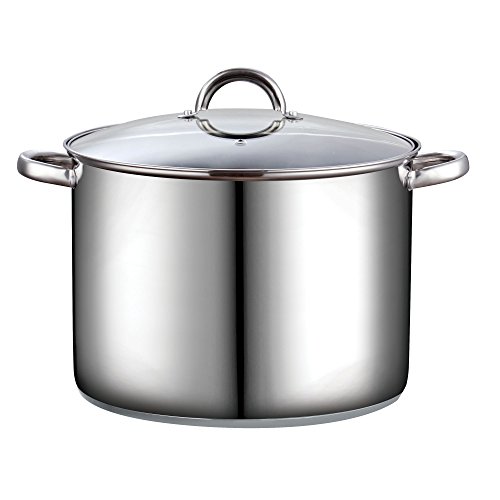The Best Large Stock Pot, According To Rigorous Testing
Looking to elevate your culinary game with the perfect addition to your kitchen arsenal? Look no further than the quest for the best large stock pot! In this comprehensive review, we'll dive into the top contenders in the market, exploring their features, durability, and performance. Whether you're simmering soups, boiling pasta, or preparing large batches of broth, finding the right stock pot is essential. Join us as we sift through the options to uncover the ultimate vessel for your cooking endeavors. Let's embark on this flavorful journey together!
Compare Products
- KR Score9.6
Kitchensradar.com established a ranking system called KR Score. KR Score is unaffected or unrelated to any websites run by manufacturers or sales agents. Learn more
- BrandNutriChef
- KR Score9.6
Kitchensradar.com established a ranking system called KR Score. KR Score is unaffected or unrelated to any websites run by manufacturers or sales agents. Learn more
- BrandCook N Home
- KR Score9.4
Kitchensradar.com established a ranking system called KR Score. KR Score is unaffected or unrelated to any websites run by manufacturers or sales agents. Learn more
- BrandCooks Standard
- KR Score9.4
Kitchensradar.com established a ranking system called KR Score. KR Score is unaffected or unrelated to any websites run by manufacturers or sales agents. Learn more
- BrandHOMICHEF
- KR Score9.4
Kitchensradar.com established a ranking system called KR Score. KR Score is unaffected or unrelated to any websites run by manufacturers or sales agents. Learn more
- BrandT-fal
- KR Score9.4
Kitchensradar.com established a ranking system called KR Score. KR Score is unaffected or unrelated to any websites run by manufacturers or sales agents. Learn more
- BrandAmazon Basics
- KR Score9.4
Kitchensradar.com established a ranking system called KR Score. KR Score is unaffected or unrelated to any websites run by manufacturers or sales agents. Learn more
- BrandCook N Home
- KR Score9.4
Kitchensradar.com established a ranking system called KR Score. KR Score is unaffected or unrelated to any websites run by manufacturers or sales agents. Learn more
- BrandCuisinart
- KR Score9.2
Kitchensradar.com established a ranking system called KR Score. KR Score is unaffected or unrelated to any websites run by manufacturers or sales agents. Learn more
- BrandFarberware
- KR Score9.0
Kitchensradar.com established a ranking system called KR Score. KR Score is unaffected or unrelated to any websites run by manufacturers or sales agents. Learn more
- BrandRachael Ray
Last update on 2024-04-16 / Affiliate links / Images, Product Titles, and Product Highlights from Amazon Product Advertising API
When it comes to making stock, the size of the pot matters. For most home cooks, a pot that can hold around 12 to 16 quarts (or 11 to 15 liters) is ideal. This size allows you to comfortably accommodate bones, vegetables, and water while still leaving enough room for simmering and evaporation. Additionally, a larger pot gives you the flexibility to make bigger batches of stock, which can be handy for meal prepping or freezing portions for later use.
How big is a 20 Litre stock pot?
A 20-liter stock pot is approximately 5.3 gallons in volume. In terms of dimensions, it typically has a diameter of around 12 to 14 inches and a height of 12 to 15 inches, depending on the specific design. This size is suitable for large-scale cooking, making it ideal for commercial kitchens or for home cooks who frequently prepare large batches of stock for canning or freezing.
Are expensive stock pots worth it?
The answer depends on your cooking needs and preferences. Expensive stock pots often boast superior craftsmanship, durable materials, and advanced features that can enhance your cooking experience. High-quality materials like stainless steel or copper distribute heat more evenly, preventing hot spots and ensuring thorough cooking. Additionally, premium brands may offer warranties and customer support, providing peace of mind and long-term value. However, if you're on a budget or don't require the features offered by expensive pots, there are plenty of affordable options that can still deliver satisfactory results.
Why are stock pots so expensive?
Several factors contribute to the high cost of stock pots. Firstly, premium materials like stainless steel, copper, or multi-ply construction are often used to ensure durability and superior heat distribution. These materials come at a higher price point compared to cheaper alternatives. Additionally, meticulous craftsmanship and attention to detail in the manufacturing process can increase production costs. Features such as ergonomic handles, tight-fitting lids, and specialized designs also add to the overall expense. Finally, brand reputation and exclusivity can drive up prices, as consumers are willing to pay more for well-known, trusted brands with a history of quality.
What pots will last a lifetime?
Pots made from high-quality materials like stainless steel, cast iron, or copper are renowned for their longevity and durability. Stainless steel pots, in particular, are resistant to rust, corrosion, and scratching, making them a popular choice for professional chefs and home cooks alike. Cast iron pots, while heavy, are virtually indestructible and improve with age, developing a natural non-stick surface over time. Copper pots offer excellent heat conductivity and control, but they require more maintenance to keep them looking pristine. Investing in pots from reputable brands known for their craftsmanship and using proper care and maintenance techniques can ensure that your pots last a lifetime and beyond.
Related Posts:
The Best Soup Pot, Expert Recommendations
The Best 8 Quart Stock Pot, Buyer’s Guide
10 Best 12 Qt Stock Pot Of 2024
Best Stock Pot Size, Easy To Use




























